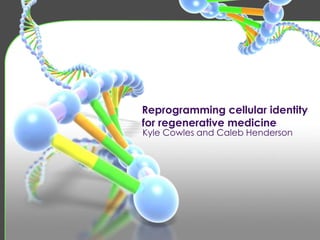
Reprogramming cellular identity
- 1. Reprogramming cellular identity for regenerative medicine Kyle Cowles and Caleb Henderson
- 2. Item 5 Embryonic stem cells Biomedical research •Abstract Patient-derived stem cells using methods of in vitro Manipulating zygote cells Modeling disease-based cells Reprogramming somatic cells into iPS or ES cells Item 1 Item 2 Item 3 Item 4
- 3. • Cellular differentiation triggered by gene expression patterns • Scientists can recover these ES cells from embryos and manipulate them in vitro to study early development • These cells change into cell types used for therapeutic purposes: transplantation • Common stem cells to specialized cells •Cellular identity iPS cells Stem cells ES cells
- 4. COMPARISON OF ITEM ONE • Study a disease mechanism to see whether the affected cell type derived from iPS cells can recapitulate the disease phenotype • Interaction among different cell types may be important to reconstruct the COMPARISON OF ITEM TWO •Reprogramming-disease based models A second line of text could go here
- 5. •Differentiation in a cell
- 6. •Two Picture Page Layout A second line of text here
- 7. In an experimental system with a reliable cellular disease phenotype readout, constancy of any two variables allows investigation of the other’s effect on the disease phenotype. •Use A second line of text may go here.
- 8. Patient-specific vs. Induced-disease models
- 9. • Pink = healthy, green = predisposed to disease. A) Healthy control cells can be cultured, reprogrammed to iPS cells, and then differentiated into a target cell type as a control for dsease phenotype assays. B) Cells from patients with monogenic or highly penetrant genetic disease predisposition can be cultured, reprogrammed, and differentiated to the cell type C) Cells affected by a disease-causing environmental or epigenetic event can be cultured, in which environmental conditions are standardized, and reprogrammed, in which the epigenome is reset. After these factors are normalized, these cells no longer carry a predisposition to disease. Thus the iPS lines and differentiated cells resulting from this approach are unlikely to demonstrate disease-specific phenotypes. D) Cells from any source can be exposed to disease-inducing environmental conditions to create a model of an environmentally-induced disorder. This could be either during reprogramming (as shown), during differentiation, or during extended culture. E) Cells from any source can be epigenetically manipulated to mimic epigenetic alterations contributing to disease. Results
- 10. • Two broad approaches could be taken to restore a missing cell type: • • 1) Creation of iPS cells followed by directed differentiation into the missing cell type, which would then be incorporated into the patient in an anatomically appropriate fashion; or 2) Direct conversion of an extant healthy cell type into the missing or damaged cell type, thus effecting cell regeneration in situ. •Future benefits